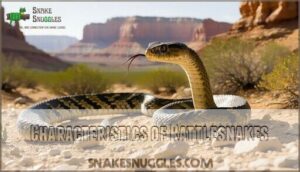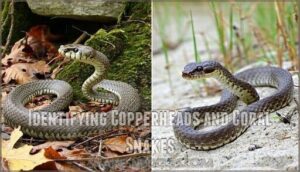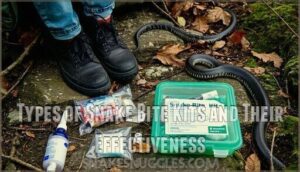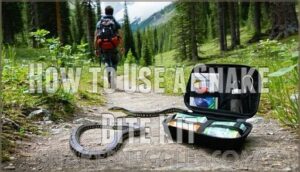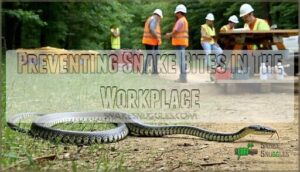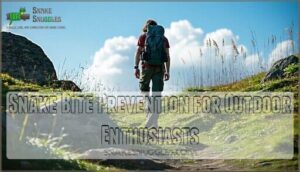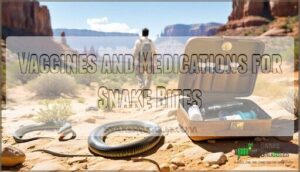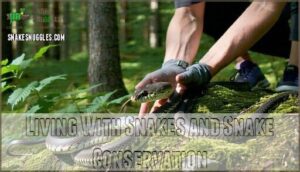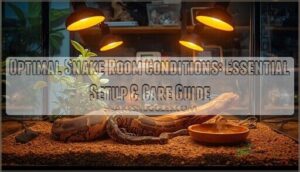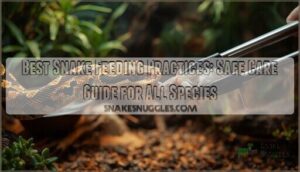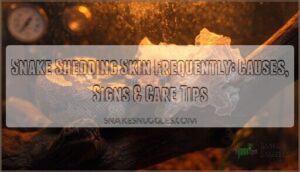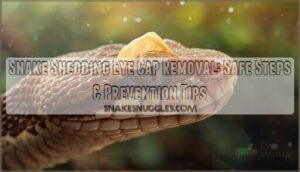This site is supported by our readers. We may earn a commission, at no cost to you, if you purchase through links.
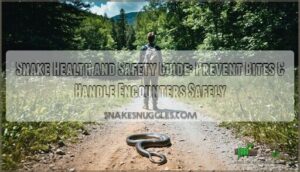
If you encounter a snake, don’t panic or make sudden movements. Back away slowly while keeping the snake in sight. Most snakes aren’t venomous, but when in doubt, treat every encounter seriously.
For bites, remove jewelry immediately, keep the affected limb still, and seek medical attention fast. Remember, snakes are more afraid of you than you are of them—they’d rather slither away than fight.
The key lies in understanding their behavior patterns and knowing which species call your area home. This knowledge can help you navigate snake encounters with confidence and safety.
Table Of Contents
- Key Takeaways
- Snake Safety Precautions
- Identifying Venomous Snakes
- Snake Bite First Aid
- Snake Bite Treatment and Prevention
- Living With Snakes and Snake Conservation
- Frequently Asked Questions (FAQs)
- What are the safety rules for snakes?
- What are the five things you should not do when caring for snake bites?
- What are the hazards when handling a snake?
- What is the safety of snakes?
- What to do immediately after a copperhead bite?
- How long can you survive a rattlesnake bite without treatment?
- How long can snakes survive without food?
- Do snakes hibernate during winter months?
- Can snakes hear or are they deaf?
- How often do snakes shed their skin?
- Conclusion
Key Takeaways
- Prevent encounters through smart preparation – Wear long pants and sturdy boots, stay on marked trails, keep pets leashed, and clear yard debris where snakes hide
- Recognize venomous species by key features – Look for triangular heads, heat-sensing pits, and distinctive patterns like rattles, hourglass markings on copperheads, or red-yellow-black bands on coral snakes
- Respond correctly during encounters – Stay calm, don’t make sudden movements, back away slowly while keeping the snake in sight, and give it space to escape
- Act fast for snake bites – Remove jewelry immediately, keep the bite below heart level, immobilize the affected area, and seek emergency medical care right away
Snake Safety Precautions
You’ll encounter snakes in various environments, from wooded trails to your own backyard, making prevention your best defense against potentially dangerous situations.
Understanding basic safety precautions helps you avoid snake encounters while protecting yourself, your family, and your pets from unnecessary risks.
Avoiding Encounters With Snakes
When you’re out exploring nature, smart snake avoidance strategies keep you safe from unwanted encounters.
These snake safety precautions create a protective barrier between you and potentially dangerous wildlife:
- Stay on safe trails and marked paths during hikes
- Wear long pants and sturdy boots for protection
- Keep pets on leashes to prevent pet protection issues
- Maintain outdoor awareness by watching your step
- Practice yard cleanup by removing debris and tall grass
Using effective snake repellent methods can also enhance safety.
Following these snake bite prevention methods and snake proofing methods guarantees your outdoor adventures remain enjoyable rather than dangerous.
Protecting Your Yard From Snakes
Your backyard doesn’t have to become a snake highway.
Start with Yard Cleanup and Debris Removal – clear rocks, brush piles, and tall grass where snakes love hiding.
Snake Fencing offers the strongest protection, while regular Pest Control eliminates their food sources.
These Snake Proofing Methods create an unwelcoming environment for unwanted visitors.
Snake-Proofing Method Effectiveness Cost
Safe Hiking and Walking Practices
Your trusty hiking boots become your first line of defense against unexpected snake encounters on the trail. Smart Trail Safety starts with proper Outdoor Gear and Wilderness Prep to keep you protected.
- Wear long pants and sturdy boots for thorough snake bite prevention
- Stay on marked trails to maintain Path Awareness and reduce risk
- Keep pets leashed to prevent them from disturbing hidden snakes
- Conduct visual sweeps of areas before sitting or resting during hikes
Pet Safety Around Snakes
Your furry companions need protection from slithering dangers during outdoor adventures.
**Keep your four-legged friends safe from venomous encounters on every trail and backyard adventure.
Pet snake-proofing starts with smart prevention strategies that keep both you and your pets safe:
- Install pet fencing around yards to create snake-free zones for playtime
- Practice snake avoidance by keeping pets leashed on trails and away from brush
- Use pet monitoring techniques to watch for defensive snake behaviors during walks
By following proper snake care guidelines, you can minimize risks and guarantee a safe environment for your pets.
What to Do in Case of a Snake Encounter
When you encounter a snake, remember that snake awareness is your best defense.
Stay calm and avoid sudden movements – most snakes prefer to retreat rather than fight. Back away slowly while keeping your eyes on the snake, giving it plenty of space to escape. These safety measures prevent most dangerous situations from escalating.
Snake Encounter Tips Important Reminders
Identifying Venomous Snakes
Knowing how to identify venomous snakes can be the difference between a safe outdoor experience and a dangerous encounter.
You’ll want to recognize the key physical features and behaviors that distinguish harmful species from their harmless look-alikes.
Characteristics of Rattlesnakes
Within western territories and beyond, rattlesnakes display unmistakable characteristics that’ll help you identify these venomous snakes safely.
Their triangular heads house heat-sensing pits for detecting warm prey, while distinctive diamond or banded snake patterns provide natural camouflage across diverse rattlesnake habitat.
The iconic rattle sounds warn of danger, though broken rattles occur frequently in wild populations through environmental wear.
Understanding rattlesnake behavior is essential for safe encounters and preventing bites.
Identifying Copperheads and Coral Snakes
Two venomous snakes require your attention when exploring the great outdoors. Snake identification becomes critical when distinguishing between copperheads and coral snakes, as both pack a dangerous bite.
Copperhead habitat spans forests, rocky areas, and suburban yards across the eastern United States. These venomous species sport distinctive hourglass-shaped markings along their bodies, with colors ranging from reddish-brown to golden tan. Adults typically measure 1.5-3 feet long.
Coral snake behavior differs substantially—they’re smaller, more reclusive, and prefer sandy or marshy environments in the southeastern states. Their snake patterns feature bright red, yellow, and black bands.
Key differences for identifying venomous snakes:
- Copperheads have thick, triangular heads with heat-sensing pits
- Coral snakes display thin bodies with banded patterns
- Copperheads are more aggressive when threatened
- Coral snakes rarely bite unless directly handled
- Remember: "Red touches yellow, kills a fellow
Cottonmouths and Other Venomous Snakes
Spotting cottonmouths requires understanding their cottonmouth habitat preferences and distinctive snake behavior. These venomous snakes inhabit swamps, marshes, and slow-moving waters across the southeastern United States, making water-side encounters more likely than with other species.
| Feature | Cottonmouth | Copperhead | Rattlesnake |
|---|---|---|---|
| Primary Habitat | Near water sources | Wooded/rocky areas | Dry, rocky terrain |
| Defensive Display | White mouth interior | Freezes when threatened | Tail rattle warning |
| Body Shape | Thick, heavy build | Moderate thickness | Varies by species |
| Head Shape | Wide, triangular | Triangular with pits | Triangular with pits |
| Coloration | Dark brown to black | Copper-brown bands | Highly variable |
Venom effects from cottonmouth bites include tissue damage and blood clotting disruption, requiring immediate medical attention. Workers can minimize risks by following snake safety protocols to prevent encounters.
Non-Venomous Snakes and Their Characteristics
Most snakes you’ll encounter are harmless helpers like Garter Snakes in gardens or Black Snakes controlling rodents.
These Non Venomous species lack the triangular heads and heat-sensing pits of dangerous varieties.
Species Identification becomes easier once you recognize their round pupils, slender builds, and predictable Snake Behavior patterns.
Understanding Snake Characteristics helps distinguish beneficial nonvenomous snakes from threats in various Snake Habitats.
Snake Behavior and Body Language
Anyone who’s encountered a snake knows that reading their body language can mean the difference between a peaceful encounter and a dangerous situation.
Understanding snake behavior and body language helps you recognize when a snake feels threatened and might strike.
Key warning signs to watch for:
- Coiled posture – Snake pulls into tight S-curves, ready to strike
- Raised head – Elevated above body level signals alertness or aggression
- Hissing sounds – Audible warning that you’re too close
- Tail rattling – Defensive behavior (not just rattlesnakes do this)
Snake posture tells the whole story.
Defensive behavior includes flattening their bodies to appear larger or forming defensive coils.
These threat displays aren’t just for show – they’re serious warnings.
Most snakes prefer escape over confrontation, so aggressive signs usually mean you’ve cornered them or they’re protecting territory.
Remember, snake behavior analysis shows that even non-venomous species use intimidating body language when stressed.
Snake Bite First Aid
When a snake bites you, recognizing the symptoms and taking immediate action can mean the difference between a minor medical event and a life-threatening emergency.
This section covers the essential first aid steps you’ll need to know if you or someone else gets bitten by a venomous snake.
Symptoms of a Venomous Snake Bite
Recognizing snake bite symptoms can mean the difference between life and death. When venom effects kick in, your body sends clear warning signals that demand immediate attention.
| Symptom Category | Early Signs (0-1 hour) | Progression (1-6 hours) |
|---|---|---|
| Local Bite Wounds | Puncture marks, bleeding | Severe swelling, blistering |
| Pain Management | Sharp, burning sensation | Intense throbbing pain |
| Systemic Effects | Nausea, dizziness | Vomiting, weakness |
| Neurological | Tingling, numbness | Muscle paralysis, vision issues |
| Circulatory | Rapid heartbeat | Blood pressure drops, shock |
Snake toxins affect everyone differently, but common symptoms of a venomous snake bite include puncture wounds, rapid swelling, and severe pain. You might feel nauseated, dizzy, or notice your vision blurring. Some people experience tingling or numbness spreading from the bite site.
Don’t wait for symptoms to worsen—emergency response starts now. Even "dry bites" without venom can become infected, requiring proper snake bite treatment and medical evaluation.
What to Do Immediately After a Snake Bite
A snake bite sends adrenaline surging, but staying calm saves lives.
Don’t panic or run – movement spreads venom faster.
Keep the bitten area below your heart and avoid ice, tourniquets, or attempting venom removal.
These first aid basics for snake bites prevent complications while you seek emergency response and professional wound care treatment.
How to Immobilize The Affected Area
After taking immediate action, keeping the bitten limb still becomes your next priority.
Movement spreads venom faster through your system, turning a manageable situation into a medical emergency.
Effective immobilization techniques include:
- Splint application – Use sticks, magazines, or cardboard to create a rigid support alongside the limb
- Bandage wrapping – Secure the splint with cloth strips or tape, keeping it snug but not tight
- Position maintenance – Keep the affected area below heart level to slow venom circulation
- Movement restriction – Avoid walking or using the bitten limb unless absolutely necessary
Think of immobilization like putting a cast on a broken bone – you’re preventing further damage while your body fights the venom.
Removing Constricting Items and Jewelry
The key to preventing complications is to remove anything that might tighten as snake bite swelling develops.
Strip off rings, watches, bracelets, and tight clothing around the bite area immediately.
Your body’s natural response creates rapid swelling that can turn jewelry into dangerous tourniquets.
This first aid for snake bites step prevents circulation problems that complicate snake bite treatment later.
When to Seek Medical Attention
After removing jewelry and tight clothing, snake bite treatment requires immediate emergency response.
Every bite needs medical attention – symptoms can escalate rapidly even if initially mild.
- Severe symptoms like swelling, numbness, or breathing difficulty signal medical emergencies requiring 911
- Venom effects vary by species, making professional evaluation critical for proper snake bite treatment
- First aid for snake bites is temporary – hospital care provides antivenom and prevents complications
Understanding snake bite first aid is essential for effective response and treatment.
Snake Bite Treatment and Prevention
While snake bite kits offer some emergency options, their effectiveness varies substantially depending on the specific contents and your ability to use them correctly under pressure.
The best treatment remains professional medical care, but understanding prevention strategies for different environments can dramatically reduce your risk of ever needing emergency intervention, which is a key aspect of professional medical care.
Types of Snake Bite Kits and Their Effectiveness
Commercial snake bite kits flood outdoor stores, but their kit effectiveness remains questionable.
Suction-based kits remove only 0.04% of venom extraction, while tourniquets risk limb damage. Pressure immobilization bandages show promise for neurotoxic bites but require proper training.
Most snake bite first aid experts agree: these kits can’t replace immediate medical care and antivenom treatment for venomous snakes.
When considering snake bite kits for emergency preparedness, this is a key factor to research reliable snake kits to make informed decisions.
How to Use a Snake Bite Kit
Snake bite kits aren’t magic wands, but they can help when used properly.
Read the kit instructions before you’re face-to-face with a rattler – trust me, you won’t want to fumble with directions while dealing with bite symptoms.
Follow each step carefully, focusing on first aid basics rather than venom removal techniques.
- Apply constricting bands only if kit instructions specifically direct you to do so
- Clean the bite area gently while monitoring for worsening symptoms
- Document the time of bite and your emergency response actions for medical professionals
- Keep the kit accessible but remember it’s just a bridge to professional snake bite treatment
Understanding proper snake bite first aid is essential in such situations.
Preventing Snake Bites in The Workplace
Effective workplace safety starts with proper hazard control and risk assessment.
Train employees on snake awareness and identification techniques specific to your region.
Conduct visual inspections of work areas before starting tasks, especially in outdoor environments.
Implement snake safety protocols including protective clothing requirements and emergency response procedures.
Regular employee training on snake bite prevention techniques reduces workplace hazards substantially.
Utilizing proper snake bite kits is vital for effective first aid and emergency response, which involves understanding snake bite treatment and having the right snake bite tools.
Snake Bite Prevention for Outdoor Enthusiasts
The great outdoors calls, but outdoor safety starts with smart preparation.
Wear long pants and sturdy boots for essential hiking precautions. Stay on marked trails and maintain snake awareness by scanning ahead, especially near rocks or tall grass.
Keep wilderness first aid knowledge fresh and learn local venomous species identification. These snake safety precautions turn your adventure into a safer, more enjoyable experience in nature’s playground.
Vaccines and Medications for Snake Bites
Understanding your options for vaccines and medications for snake bites can make the difference between life and death. Currently, antivenom remains the gold standard for snake bite treatment and prevention, though researchers are developing promising alternatives.
Here’s what you need to know about antivenom types and snake bite vaccines:
- Antivenom must match the specific snake species for maximum effectiveness
- Emergency dosage timing is vital—delays substantially increase complications
- Venom treatments like universal antivenoms show promise in lab studies
- Medication effects vary, with some causing allergic reactions requiring medical supervision
Most snake vaccines target specific species like rattlesnakes, offering partial protection rather than complete immunity.
Living With Snakes and Snake Conservation
You don’t have to fear snakes to respect them—they’re actually valuable neighbors who control rodent populations and keep ecosystems balanced.
Learning to coexist with these misunderstood creatures protects both your family and the environment while supporting conservation efforts that benefit everyone.
The Importance of Snakes in The Ecosystem
Nature’s pest control squad works around the clock, with snakes serving as ecosystem balance champions.
These predators maintain biodiversity support by controlling rodent populations that would otherwise devastate crops and spread disease.
Snake conservation efforts protect habitat preservation, ensuring wildlife management systems function properly.
Without these silent guardians, agricultural losses would skyrocket while disease vectors multiply unchecked throughout communities.
How to Coexist With Snakes in Your Yard
Your yard doesn’t have to be a battleground between you and slithering neighbors. Smart yard maintenance creates peaceful coexistence through strategic habitat modification.
- Remove snake deterrents naturally: Clear debris, woodpiles, and tall grass where snakes seek shelter, making your space less appealing for nesting.
- Install proper fence installation: Use hardware cloth buried 6 inches deep with a 30-degree outward angle to create effective snakeproofing barriers.
- Implement wildlife control wisely: Encourage natural predators like owls and hawks while maintaining snake habitat awareness through regular property inspections.
These snake safety tips transform your yard into a zone where protecting your yard from snakes aligns with snake conservation efforts.
Snake Conservation Efforts and Laws
Beyond backyard coexistence, snake conservation operates through powerful legal frameworks.
The Endangered Species Act protects threatened species like giant garter snakes, while CITES regulates international trade of over 40,000 species.
State laws vary—some protect all native snakes, others allow removal under direct threat.
Wildlife protection succeeds through habitat preservation, community education, and enforcement preventing illegal trafficking.
Understanding snake laws regulations is essential for traversing the complex landscape of snake ownership and conservation.
Relocating Snakes Safely and Humanely
Professional snake relocation requires wildlife experts who use humane traps and proper snake handling techniques.
Don’t attempt DIY snake removal – it’s dangerous and often illegal.
Licensed wildlife removal services understand local regulations and use safe transport methods. These professionals assess each situation, ensuring both your safety and the snake’s welfare.
They’ll relocate the snake to appropriate habitat where it can thrive naturally.
Education and Awareness About Snakes
Breaking down snake myths opens doors to better wildlife education and safer encounters.
Understanding reptile facts helps you make informed decisions during unexpected meetings.
Here’s how snake education transforms your perspective:
- Snake myths debunked – Learn that most snakes aren’t aggressive and prefer avoiding humans
- Reptile facts clarified – Discover how snake behavior indicates their intentions and stress levels
- Wildlife education expanded – Understand each species’ role in controlling pest populations naturally
- Snake safety improved – Recognize warning signs and appropriate responses during encounters
- Conservation efforts supported – Appreciate why protecting snake habitats benefits entire ecosystems
This knowledge builds confidence for snake bite prevention while fostering respect for these misunderstood creatures.
Frequently Asked Questions (FAQs)
What are the safety rules for snakes?
Wear long pants and sturdy boots when outdoors.
Stay on marked trails, keep pets leashed, and remove yard debris.
Watch for triangular heads and rattles. If bitten, stay calm, immobilize the area, and seek immediate medical attention.
What are the five things you should not do when caring for snake bites?
Don’t apply tourniquets, cut the wound, suck out venom, use ice, or give alcohol. These outdated methods worsen tissue damage and delay proper medical treatment you’ll need.
What are the hazards when handling a snake?
When you handle snakes, you’re risking bites, scratches, and stress-induced defensive behaviors. Improper technique can cause constriction injuries, escapes, or respiratory issues from frightened snakes striking unexpectedly.
What is the safety of snakes?
You’ll find snakes surprisingly safe when you respect their space and understand their behavior.
Most species avoid humans naturally, preferring to retreat rather than confront.
They’re defensive creatures, not aggressive predators, and will act accordingly when given their space.
What to do immediately after a copperhead bite?
Copperheads cause 37% of venomous snake bites in the U.S., making quick action essential.
Stay calm, remove jewelry immediately, keep the bite below heart level, and seek emergency medical care right away.
How long can you survive a rattlesnake bite without treatment?
Without medical treatment, you’ll likely survive several hours to days after a rattlesnake bite, but time’s ticking fast.
Severe envenomation can prove fatal within hours, while mild bites might give you more time.
Don’t gamble—seek emergency care immediately.
How long can snakes survive without food?
Time can be a fickle friend for snakes – they’re remarkably resilient creatures that can survive months without food, typically lasting 2-6 months depending on species, size, and environmental conditions.
Do snakes hibernate during winter months?
Snakes don’t truly hibernate but enter brumation, a slower state where they’re less active but still move occasionally.
You’ll find them seeking shelter in dens, under rocks, or burrows during colder months.
Can snakes hear or are they deaf?
Ironically, creatures that slither silently through grass aren’t actually deaf.
You’d be surprised—snakes can’t hear airborne sounds like you do, but they’re incredibly sensitive to ground vibrations through their jawbones, detecting approaching footsteps better than many hearing animals, which makes them incredibly sensitive to their environment and allows them to detect approaching footsteps.
How often do snakes shed their skin?
You’ll notice your snake sheds its skin every 4-8 weeks, depending on age and growth rate. Younger snakes shed more frequently than adults since they’re growing faster.
Conclusion
Knowledge becomes your shield against danger—this snake health and safety guide transforms fear into confidence through understanding.
By following proper prevention techniques, recognizing venomous species, and knowing correct first aid procedures, you’re equipped to handle snake encounters safely.
Remember, most snakes aren’t aggressive and prefer avoiding humans entirely.
Whether you’re hiking, gardening, or simply enjoying nature, these evidence-based strategies protect you and your loved ones while respecting these important ecosystem contributors.
- https://www.ingleside.com/services/other-pets/blog/common-health-problems-pet-snakes
- https://vcahospitals.com/know-your-pet/snakes-diseases
- https://www.vettimes.com/clinical/exotics/snakes-husbandry-and-common-health-problems-cpdreptiles
- https://www.merckvetmanual.com/all-other-pets/reptiles/disorders-and-diseases-of-reptiles
- https://familysnake.com/guides/keeping-your-slithery-friends-secure-escapism-prevention-for-snake-enclosures/

